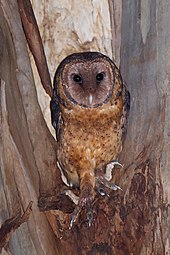Tasmanian masked owl
| Tasmanian masked owl | |
|---|---|

| |
| Male | |
| Scientific classification | |
| Domain: | Eukaryota |
| Kingdom: | Animalia |
| Phylum: | Chordata |
| Class: | Aves |
| Order: | Strigiformes |
| Family: | Tytonidae |
| Genus: | Tyto |
| Species: | |
| Subspecies: | T. n. castanops
|
| Trinomial name | |
| Tyto novaehollandiae castanops | |
| Synonyms | |
| |

The Tasmanian masked owl (Tyto novaehollandiae castanops) is a bird in the barn owl
"…a species distinguished from all the other members of its genus by its great size and powerful form. Probably few of the Raptorial birds, with the exception of the Eagles, are more formidable or more sanguinary in disposition."
"Forests of large but thinly scattered trees, skirting plains and open districts, constitute its natural habitat. Strictly nocturnal in its habits, as night approaches it sallies forth from the hollows of the large gum-trees, and flaps slowly and noiselessly over the plains and swamps in search of its prey, which consists of rats and small quadrupeds generally."[4]
Description
Tasmanian masked owls are not only large, but robust. They closely resemble a barn owl, however are many times larger. Females weigh up to 1.26 kilograms (2.8 lb) with a wingspan of up to 129 centimetres (51 in). Their plumage is mainly a variable combination of browns and greys, generally darker than the other Australian subspecies. Their upper parts are dark brown to pale chestnut, with white speckling. Females are considerably darker, as well as larger, than the males, ranging from 43 to 57 centimetres (17 to 22 in) in length, compared with the males’ 35 to 42 centimetres (14 to 17 in). They have broad, black-bordered, buff to chestnut facial discs, and fully feathered legs with powerful feet and long talons.
Distribution and habitat
The natural range of the owl is limited to Tasmania, where it has been recorded throughout the state, with the exception of the south-west. The owls inhabit both wet and dry eucalypt forests, woodlands and adjoining areas of agricultural land. Preferred habitat is areas close to the forest edge, containing a mosaic of understorey components. They require large old-growth trees with capacious hollows for nesting. The home range of a breeding pair may be more than 10 km2 (3.9 sq mi); areas identified as important for breeding include the east coast between Hobart and St Marys, the Derwent and Huon Valleys and the mid-north coast, as well as fragmented patches in the Tamar Valley and the north-east coast. It has been recorded from Maria and Bruny Islands.[5]
The owl has also been successfully introduced to
Behaviour
These owls are secretive, relatively silent, and strictly nocturnal birds. They roost during the day, usually in trees in dense foliage or hollows, as well as in rocky overhangs and caves, and occasionally in farm sheds and other open buildings.[5]
Breeding
These owls breed as
Anecdotally, Tasmanian masked owls were first
Feeding
These owls hunt at night, preying on a wide range of animals, from insects to mammals as large as rabbits, bandicoots and brushtail possums. Their main diet includes introduced rodents and rabbits in agricultural areas, and marsupials and native birds in less disturbed habitats. They often hunt from perches using sound to detect prey, which is usually taken on the ground by striking with the feet and using the talons to pierce and kill.[6]
Voice
Among their calls, Tasmanian masked owls utter a loud, rich, hissing or rasping screech, the call of the female being deeper and harsher than that of the male. They also snap their beaks loudly as a warning against perceived threats.[6]
Status and conservation
Tasmania
The Tasmanian masked owl is considered to be
Lord Howe Island
Between December 1922 and October 1930 almost 100 masked owls, mostly from Tasmania, were introduced to Lord Howe Island in an unsuccessful attempt to control black rats. The population there is considered to be a threat to the endemic Lord Howe woodhen and Lord Howe currawong, as well as to breeding seabirds, and is culled when possible.[6][9][10]
References
- Department of the Environment. Retrieved 10 April 2015.
- ^ Gould, John (1837). "Characters of three New Species of Strix". Proceedings of the Zoological Society of London. 4 (48): 140.
- ISBN 0-207-19821-7.
- ^ Gould, John (1972) [1865]. Handbook to the Birds of Australia. Melbourne: Lansdowne Press. pp. 62–64 (vol.1).
- ^ a b c Anon. (10 October 2002). Threatened Fauna Manual for Production Forests in Tasmania – Masked Owl (draft).PDF download Archived 2009-09-13 at the Wayback Machine
- ^ ISBN 0-19-553071-3.
- doi:10.1071/MU948169.
- ^ ISBN 0-642-54683-5.
- ISBN 0-646-02638-0.
- ^ Hutton, Ian (2006). "Masked Owls culled" (PDF). Friends of Lord Howe Island Newsletter. 19.

